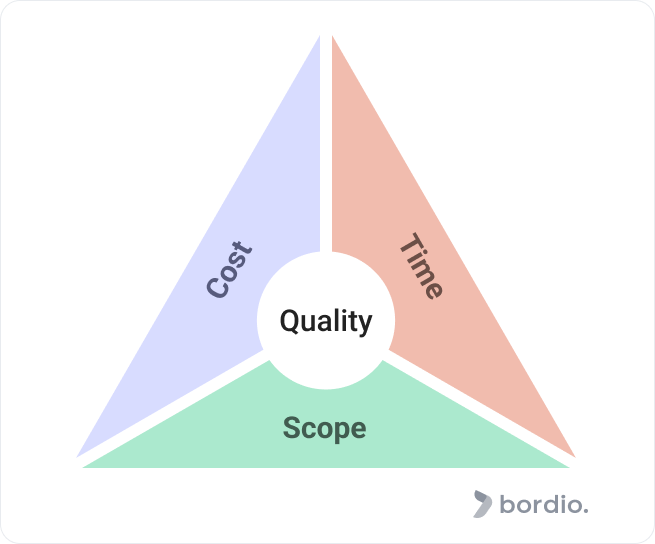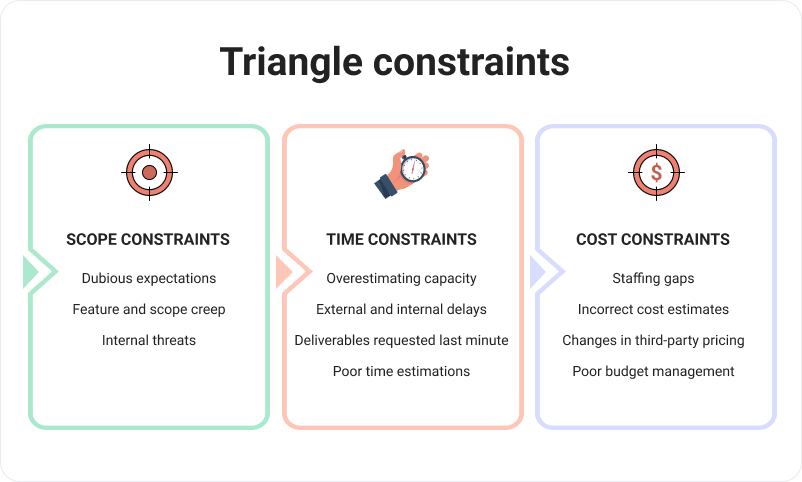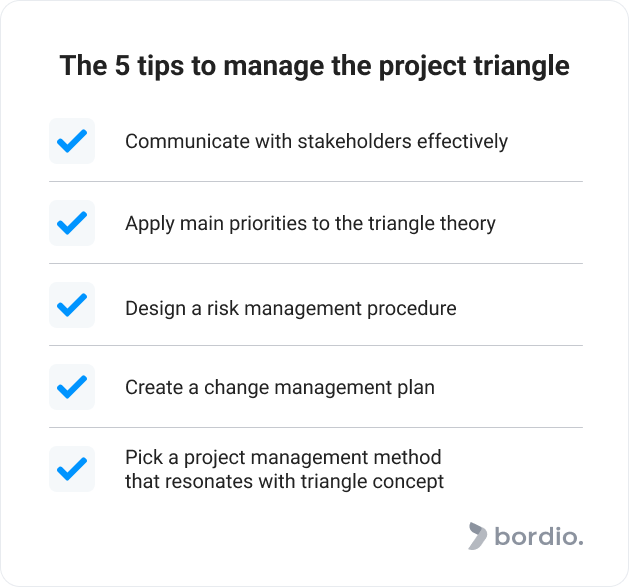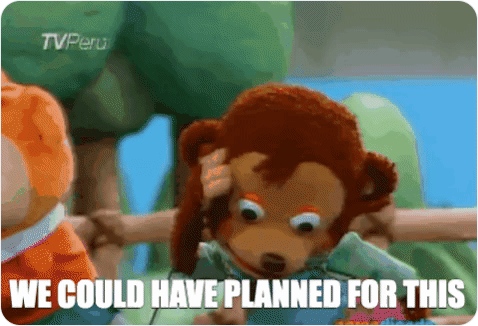The project management triangle is sometimes referred to as project management constraints, quality triangle, or iron triangle and consists of the 3 elements:
- Time
- Cost
- Scope
Those 3 elements represent the ultimate triple constraint of any project as all project-related activity is limited by them. They are heavily interdependent and together ensure the optimal quality of the project outcome.
A successful project manager, on top of everything else that PMs do, has to balance the three constraints in order to deliver a high-quality solution at the end of the project.
The 3 elements of the project management triangle explained
The iron triangle is discussed during project initiation and is outlined in the project implementation plan.
Let’s go into a bit more detail about what each of the three constraints means, and look at the scope, time, and cost individually.
Scope
Scope refers to the size of the project. It is identified during the project planning phase and includes all project activities, a.k.a. the work that has to be done in order for the project to be completed.
The project’s scope contains the goals and the guidelines for project managers that help them navigate the project.
Project success is a fragile concept. The change in scope once the project has already started can have detrimental consequences. So it is extremely critical to have the scope designed thoroughly to minimize any changes and deviations.
Possible constraints with project scope:
- Expectations that are hard to measure (e.g. because of dubious shareholder requirements).
- The feature creep (when feature requests come through after the plan was approved).
- The scope creep (as a result of the changing requirements or specifications).
- Internal threats (conflicts or misunderstandings among stakeholders).
Time
Time element includes the project timeline, hours worked on the project, time allocated for different phases like planning or implementation.
Possible time constraints are:
- Overestimating the project team’s capabilities and productivity.
- External delays (for example, suppliers might push back the delivery of materials).
- Internal factors (maybe someone got sick and couldn’t finish their part on time).
- Deliverables were added to the project scope after the plan was approved.
- Incorrect time estimation at the planning stage.
Tip: Productivity can be improved with the help of useful tips and also technology. Using a digital calendar planner will help everyone stay organized and finish more tasks on time. If you’re looking for tricks to help your co-workers, read our guide on improving team productivity.
Cost
In terms of the triple constraints, the cost element of the triangle goes beyond the simple financial expense in the project’s budget. The cost constraint counts all resources that are utilized in project execution, like equipment, materials, tools, and human resources.
Possible cost challenges are related to:
- Staffing gaps (like not having enough staff for the workload due to miscalculations).
- Incorrect cost estimates during the project planning phase.
- Unforeseen changes in supplier pricing.
- Deliverables were added late to the project scope.
- Irresponsible budget management (when no one keeps track of expenses).
Relationship between the project management triangle elements
When talking about the project management and project management triangle, it is important to understand that they are heavily dependent on one another, with a change in one of them leading to a shift in the balance between the three.
The scope is directly proportional to time and cost. If the scope increases, it means that time and cost will also increase to accommodate extended scope demands.
If cost is reduced, more often than not the time is extended, i.e. their relationship is inversely proportional because the smaller group will be using fewer resources to reach the result.
In case the time is reduced, the cost is likely to go up. Because in order to achieve more in a shorter timespan, more resources have to be incorporated.
The triangle is balanced when the scope equals cost plus time.
The changes in any element of the project triangle lead to project managers having to decide where to make compromises and what those compromises should look like. Many go back to the team’s digital weekly planner and look for features to remove from the pipeline to bring everything back to balance. We recommend you take a closer look at free schedule planner online and also modern schedule builder from Bordio to work on your projects. It is a tough part of being a project manager as their decision will have a huge impact on the overall project. You can read more about the roles and responsibilities of project managers in our dedicated article.
Why is the project management triangle a widely celebrated theory
The iron triangle demonstrates the fragile balance and interdependence of all project-related aspects. Project management is a science on its own, so every step that the project team and the project manager decide to take has consequences and affects the project execution.
Among the top 3 reasons why the triangle model is praised are:
-
It highlights interdependencies in the project – how one small change has the potential to influence the rest.
-
Enhances risk management – project triangle focuses on the absolute keys of every project (scope, time, cost). And those who understand them will endure fewer risks later on.
-
The project triangle helps identify the priorities of the project and focus on what truly matters to complete the project successfully.
Additionally, the project triangle gives us a much-needed reality check. We can’t always have it all. A project cannot be fast, cheap, and high-quality simultaneously. Well, maybe it can, sometimes, but for the most part, it’s not possible!
The project management triangle teaches us that trade-offs are inevitable and we have to learn to work with them.
Tips to manage the project triangle
The project management triangle should be handled with care in order to achieve the project’s goals.
We prepared 5 tips for anyone looking to master the project management triangle model and achieve the best results with it.
#1 Effective communication with stakeholders is a priority
Project Management Institute attributes the primary reason in projects fails to insufficient or incorrect communication with stakeholders.
In terms of the project management triangle, it is vital to be on the same page with stakeholders who have the potential to disrupt the project constraints with changes and alterations.
Many people who are not deeply involved in project management, do not understand the interdependencies. So when they call the project manager 1 month before the project deadline asking for new cool functionality to be squeezed in, they usually mean no harm.
A good project manager will dedicate the time to explain the nuances of the process to everyone, in addition to keeping stakeholders informed about the ongoing project progress. A good practice is to develop a project communication plan to help everyone communicate more efficiently and know exactly who to message with a question. There are already many things on the PM’s online to-do list. And Bordio has perfect online planner for you. However, making time to create a process here will pay off with time savings and fewer conflicts down the line.
#2 Choose your main priorities and apply them to triangle management
It’s not a working solution to have all three constraints set in stone. If that’s the case with your project, then any change or adjustment will kill your chances of positive project delivery.
In order to avoid a hard crash, some of the project constraints have to be flexible. For example, if you must finish the project before a certain deadline, you should be more relaxed with the remaining triangle elements to support your goal. So, if time is the key point, then the team sticks to every task on their daily planners, and the cost can be increased to support that. Use weekly schedule planner free and get better at planning.
So, pick up the absolute key constraint that cannot be adjusted no matter what, approve it with the stakeholders, and keep going.
#3 Have a risk management procedure in place
Some industries tend to be riskier than others, but you must think about risks no matter what you do.
So, dedicate time to planning your risk management strategy:
- Identify all possible risks.
- See which risks can be eliminated from the beginning and do it.
- Have a mitigation plan ready for the remaining risks.
Create a standardized list of actions for any unforeseen risks. And make sure you get formal approval from key shareholders before the project goes ahead to eliminate any potential difficulties moving forward.
The last thing you need when a risk comes up is panic. And with a clear path that project managers and teams will rely on, you will enjoy a calm and thought-through reaction to anything life throws at you. A good PM will use remote collaboration tools for business if you work remotely to schedule tasks. Planning ahead will make your life easier and prevent panic, so use daily schedule planners and weekly schedule makers to make your life easier. For remote teams it would be especially helpful to use tools for managing remote employees.
#4 Create a change management plan
Project management is prone to change and successful project execution sometimes comes down to how well you are ready to face the changes coming.
Similar to addressing risks, one of the best ways to deal with changes (good and bad) is to have a structured action plan that outlines the way you process the change.
Sometimes change is inevitable, for example, in events of force majeure. In other cases, it comes in the form of a possibility, like when a shareholder suddenly wants to add something to the product.
When creating a change management plan, make sure you include the following information:
- Who needs to be notified of the change.
- Who approves/declines the change request.
- Who is in charge of implementing the change.
An action plan will avoid panic and impulsive decisions, helping the project manager minimize the risks and reduce any negative impact on the operations. And if your team is working online you can make plans and manage work in best remote collaboration tools.
#5 Work with a project management methodology that aligns with the triangle concept
Luckily for us, the project management triangle is a basic concept that can be (with a bit of creativity) implemented in any project management framework.
It means that project managers can choose the method that they want to manage their projects with and still make the most of the triple constraints.
However, some methodologies lean more towards specific elements of the triangle with less focus on other constraints. So, to avoid conflicts in approaches and standards, it is recommended to choose a project management methodology with triple constraints in mind.
If time constraint is the key priority for the project manager, then Agile, Scrum, and Kanban frameworks would be a better choice. All of them focus on streamlining the processes and reducing the time from ideation to delivery.
With the project cost on the top of mind, Waterfall and Lean would be a more logical choice. These methodologies prioritize a strict budget over a strict project schedule, allowing the project to go on for a little longer if that means the total costs will remain unchained in the end.
If you’re not sure what route you should take for your projects, have a look at our best project management books list and our time manager online, where the best advice and guidelines are summed up in an easily readable format to help you decide.








